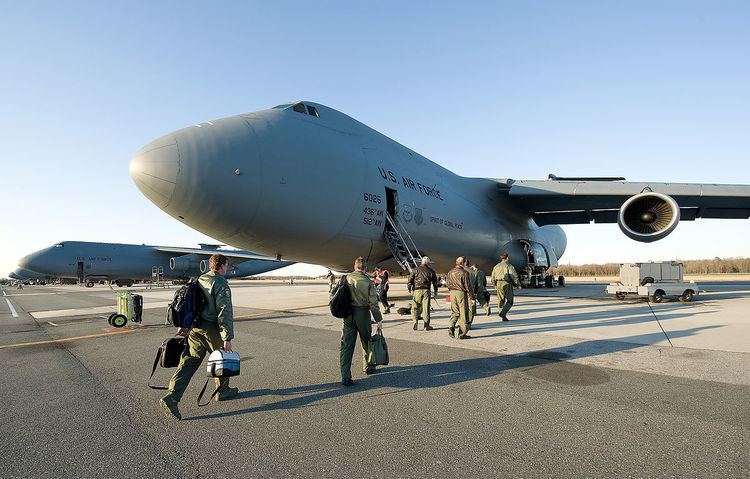Size Airlift | ||
 | ||
Active 1943–19451947–19491973–present Part of Air Force Reserve Command Garrison/HQ Dover Air Force Base, Delaware | ||
The 709th Airlift Squadron is part of the 512th Airlift Wing at Dover Air Force Base, Delaware.
Contents
- Mission
- Training in the United States
- Combat in the European Theater
- Pre Korean War reserve operations
- Reserve associate operations
- Lineage
- Assignments
- Aircraft
- References
The squadron was first activated during World War II as the 709th Bombardment Squadron. After training in the United States, it deployed to the European Theater, where it engaged in strategic bombardment missions against Germany. It returned to the United States, where it was inactivated in the fall of 1945.
The squadron was briefly activated in the reserves from 1947 to 1949. In 1973, the squadron was redesignated the 709th Military Airlift Squadron and activated at Dover as a reserve associate unit of the 436th Military Airlift Wing. Its reservists operated the 436th's C-5s alongside members of the regular Air Force.
Mission
Since 1973 the squadron has trained for and flown airlift missions with the C-5 Galaxy, It also participates in exercises and global humanitarian and contingency operations.
Training in the United States
The squadron was first activated on 1 May 1943 at Ephrata Army Air Base, Washington as the 709th Bombardment Squadron, one of the squadrons of the 447th Bombardment Group.
The original mission of the squadron was to be an operational training unit. However, by the time the 447th group reached full strength in October it had been identified for overseas deployment and its key personnel were assigned to the Army Air Forces School of Applied Tactics at Orlando Army Air Base, Florida for advanced tactical training. The cadre trained at Brooksville Army Air Field with the 1st Bombardment Squadron, engaging in simulated attacks against Mobile, Charleston and New Orleans. The squadron then trained at Rapid City Army Air Base, South Dakota with the 17th Bombardment Training Wing. In June 1943 the group moved to Harvard Army Air Field, Nebraska for Phase I training. The unit sailed on the RMS Queen Elizabeth on 23 November 1943 and arrived at the Firth of Clyde on 29 November 1943. The squadron's B-17s began to move from the United States to the European theater of operations in November 1943.
Combat in the European Theater
The squadron was stationed at RAF Rattlesden, England, from December 1943 to August 1945. It flew its first combat mission on 24 December 1943 against a V-1 missile site near Saint-Omer in Northern France.
From December 1943 to May 1944, the squadron helped prepare for the invasion of the European continent by attacking submarine pens, naval installations, and cities in Germany; missile sites and ports in France; and airfields and marshaling yards in France, Belgium and Germany. The squadron conducted heavy bombardment missions against German aircraft industry during Big Week, 20 to 25 February 1944.
The unit supported the invasion of Normandy in June 1944 by bombing airfields and other targets. On D-Day the squadron bombed the beachhead area using pathfinder aircraft.
The squadron aided in the breakthrough at St. Lo, France, and the effort to take Brest, France, from July to September 1944. It bombed strategic targets from October to December 1944, concentrating on sources of oil production. It assaulted marshalling yards, railroad bridges and communication centers during the Battle of the Bulge from December 1944 to January 1945. In March 1945 the group bombed an airfield in support of airborne assault across the Rhine. The unit flew its last combat mission on 21 April 1945 against a marshalling yard at Ingolstadt, Germany.
The 709th redeployed to the United States during the summer 1945. The air echelon ferried their aircraft and personnel back to the United States, leaving on 29 and 30 June 1945. The squadron ground echelon, along with the 711th squadron sailed 3 August 1945 on the SS Benjamin R. Milam, from Liverpool. Most personnel were discharged at Camp Myles Standish after arrival at the port of Boston. A small cadre proceeded to Drew Field, Florida and the squadron inactivated on 7 November 1945.
Pre-Korean War reserve operations
Two years later, on 25 July 1947, the 709th was redesignated the 709th Bombardment Squadron, Very Heavy. It was activated in the Air Force Reserve on 10 November 1947, at Bergstrom Field Texas, and equipped with Boeing B-29 Superfortresses. The squadron was inactivated in June 1949 when its parent group moved to Castle Air Force Base, California and became a corollary unit of the 93d Bombardment Group.
Reserve associate operations
The squadron was redesignated the 709th Military Airlift Squadron and activated as a Military Airlift Command reserve associate C-5 Galaxy squadron in 1973 and was associated with the 436th Military Airlift Wing. The associate program meshes active-duty and reserve units using the active-duty host aircraft and equipment for training.
Since 1973 the 709th has trained for and flown airlift missions, participating in exercises and global humanitarian and contingency operations.
In December 1989 through January 1990, the 709th participated in Operation Just Cause, which removed Manuel Noriega from power in Panama. Later that year, the squadron was called to active duty to support Operations Desert Shield and Desert Storm. In 2004 and 2005 reserve crews from Dover supported humanitarian relief operations following the tsunami in Indonesia and Hurricane Katrina.
